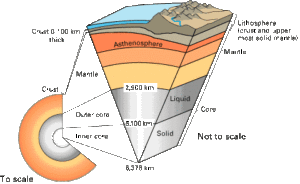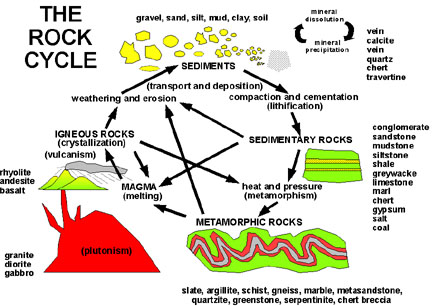Earth Sciences and Ecology
Geology
By Mark Ciotola
First published on April 30, 2019. Last updated on May 8, 2019.
Geology As The Study of Processes
When most people view a rock, be it a mundane block of granite or a sparkling diamond, they regard it as a static object. When a geologist views a rock, they see the current result of a series of processes. Many geologic processes can take millions or even billions of years. Rocks and geologic formations each tell a story of what happened during those eons of time.
The Earth As A Living System
A physicist might define being alive as equivalent to producing entropy (e.g. consuming high level energy). A system is alive to the extent that is it producing entropy. By that definition, the Earth is an extremely lively planet. The Earth is a prodigious consumer of nuclear energy in its core. Heavy, radioactive elements are continuously decaying and producing a tremendous amount of heat. (This is why a cave can be much warmer than the Earth’s surface on a cold, winter day.) In this manner, the Earth is like a human, generating inner heat and shedding it into the atmosphere and ultimately into space.
Structure of the Earth

Interior of the Earth. Photo credit: USGS.
The Earth is covered with a rocky surface surrounding a hot inner, semi-liquid core. The interior of the Earth is heated by radioactive decay. Upon the interior, large granite continents on tectonic plates literally float and drift. Earthquakes can occur where these places grate, drag and overlap each other. The temperature of the Earth gradually decreases further from the center.
The Rock Cycle
Minerals at the surface initially formed due to volcanic activity. Such are called igneous minerals and include quartz, feldspar and basalt. They tend to be quite hard. However, on the surface, the surface breaks up into rocks, which are further worn down by heat, cold and water into sediments such as sands and clays. Such minerals are called sedimentary and can form into limestone and shale. If these minerals become trapped under other sediment under high pressure, the grains can attach to each other and form metamorphic minerals, such as quartzite and slate.

Rock cycle (credit: U.S. Geological Service)
Origin of Fossil Fuels
When organic matter gets trapped under layers of sediments, fossil fuels such as coal and petroleum can form. Carbon dioxide gets trapped in these fossil fuels until mined and burnt. Limestone also traps much carbon dioxide, until it gets used for concrete.
Implications of Geological Phenomena
Large volcanic eruptions can temporarily affect global weather by placing considerable dust and greenhouse gasses in the air. The tectonic plate movement may be involved in the sequestration of carbon dioxide (Ward and Brownlee, 2000.)
Reference
- Peter Ward and Donald Brownlee, The Rare Earth, Why Complex Life Is Uncommon in The Universe, 2000.